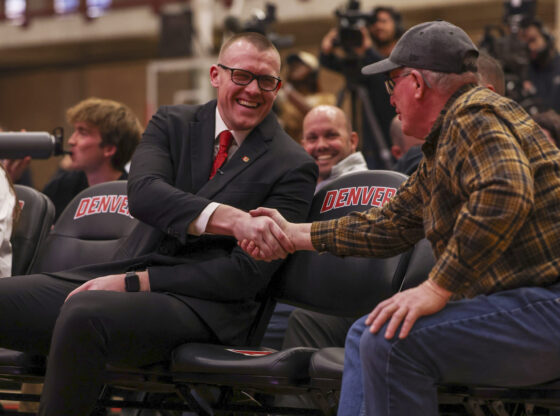“Who cares about lava flows?”
This was the opening question of “Up Close and Personal With Lava Flows,” a lecture on types of lava and the geological shapes they leave.
According to volcanologist Ken Hon, everyone should care about lava flows, even if they don’t live in Hawaii. There are some volcanoes on the mainland, in places such as Idaho, New Mexico and Washington State.
The lecture was given by two geology professors and volcanologists from the University of Hawaii at Hilo, Hon and his wife, Cheryl Ganseki. A small group of students attended, but the majority of guests were members of Sigma Xi, the University of Denver’s science and engineering honor society, or the Women’s Library Association. Both groups sponsored the talk with The Scientific Research Society Lecture.
The lecture began with Dr. Hon describing the two types of lava that he studies in Hawaii. The two types are ‘A,’ which has a crumbly, porous appearance when it cools and Pahoehoe, which becomes smooth and shiny when it cools.
Unlike tornado watching or stormchasing, observing lava flows is a fairly safe thing to do, according to Hon. It is also very interesting to watch.
“Lava flows are truly amazing natural phenomena,” said Hon.
Hon showed slides with pictures of lava flows. Some were cooled and hardened, while others were still glowing.
After going through pictures of lava flows, Hon explained the science behind how the flows eventually cool and stop. He kept it simple, however, because not everyone in the room was a geologist.
“No partial differential [equations] for this afternoon,” Hon said when explaining that lava flows are generally very thin to begin with, and inflate while cooling.
Along with the fascinating geological features they can create, Hon also showed the destructive power of lava flows.
He put up on the screen a picture of a Hawaiian town destroyed by lava in May of 1990. In the picture, telephone poles and street signs could be seen sticking out of the lava.
Hon and Ganseki have been studying and filming the continuous, 20 year long eruption of Kilauea, as well as other eruptions and lava flows.
Recently, they amalgamated what they considered to be their best footage onto a video, which they called “Up Close and Personal With Lava Flows.”
“I go through a lot of boots doing this,” Hon said, addressing the habit of standing on mostly cooled lava flows to get pictures.
After Hon’s pictures and descriptions of lava types, Ganseki played the “Up Close and Personal With Lava Flows” video, saying that she hoped the audience would understand the video’s explanations if Hon’s had gone over their heads.
She explained that sometimes it is simply easier to observe the activity of lava than to try and have it explained.












